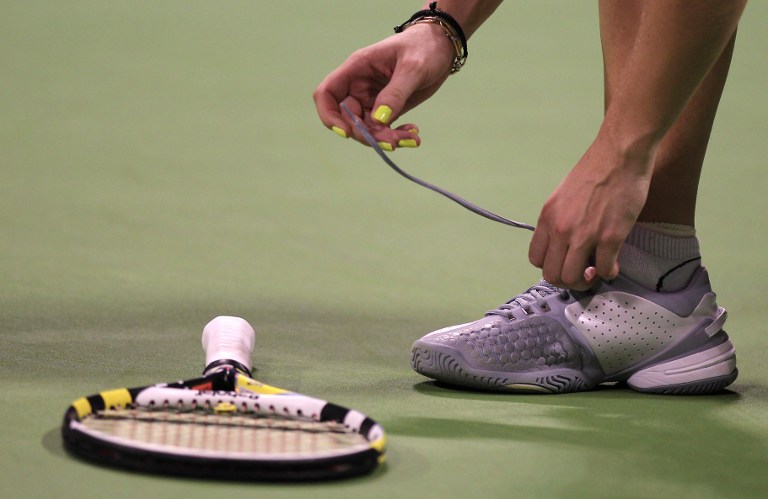‘Catastrophic failure’: Why shoelaces come undone

This file photo taken on October 31, 2010, shows Caroline Wozniacki of Denmark tying her shoelace during her WTA Championships final tennis match against Kim Clijsters of Belgium at the Khalifa International Tennis Complex in Doha on October 31, 2010. A mystery as old as laced shoes was unraveled on April 12 by experiments that reveal how shoestrings come undone when we are on the move. “The failure of the knot happens in a matter of seconds, often without warning, and is catastrophic,” scientists reported in the journal Proceedings of the Royal Society A. The researchers meant “catastrophic” in a technical sense of complete, or total collapse — once the loosening begins, there’s no stopping it. AFP
PARIS, France — A mystery as old as laced shoes was unraveled Wednesday by experiments that reveal how shoestrings come undone when we are on the move.
“The failure of the knot happens in a matter of seconds, often without warning, and is catastrophic,” scientists reported in the journal Proceedings of the Royal Society A.
The researchers meant “catastrophic” in a technical sense of complete, or total collapse — once the loosening begins, there’s no stopping it.
READ: Man buys a new pair of shoes for a boy he saw walking barefoot
But while the cost of a straggling shoelace is rarely higher than a scraped knee or the time it takes to bend down and retie a bow, sometimes the consequences can be devastating.
Lace-related accidents dot local media around the world: the van driver who killed a motorcyclist when his shoestring — wound tight around the accelerator — prevented him from lifting his foot off the gas; the boy whose leg got pulled into the gears of an escalator; the cyclist who went head-over-handlebars into traffic.
Millions of shoelaces surely come unfurled every day, and yet the mechanics of that process had never been thoroughly examined.
To tackle the enigma, a trio of mechanical engineers at the University of California at Berkeley filmed a knot — on the shoe of a researcher running on a treadmill — coming undone in extreme slow motion.
The images suggested a two-pronged attack on the knot’s integrity.
A double whammy
“When running, your foot strikes the ground at seven times the force of gravity,” stretching and relaxing the knot, said co-author Christine Gregg, a graduate student.
And then — as the knot relaxes — the legs swings into motion, applying additional force.
“A double whammy of stomping and whipping forces acts like an invisible hand, loosening the knot and then tugging on the free ends of your laces until the whole thing unravels,” the researchers explained in a statement.
Follow-up tests with a mechanical foot-and-leg showed that some laces were better than others, but none were impervious to failure.
Of the two most commonly used knots to tie shoes, one is “weak” and the other “strong,” the study found.
The strong version is based on a square knot, which is more symmetrical, while the so-called “false” knot twists when tightened rather than lying flat.
Both fail in the same way, but one takes longer than the other.
“We were able to show that the weak knot will always fail and the strong knot will fail at a certain time scale,” said professor Oliver O-Reilly, whose lab conducted the experiments.
“But we still do not understand why there’s a fundamental mechanical difference,” he added, leaving another knotty mystery to be solved. CBB